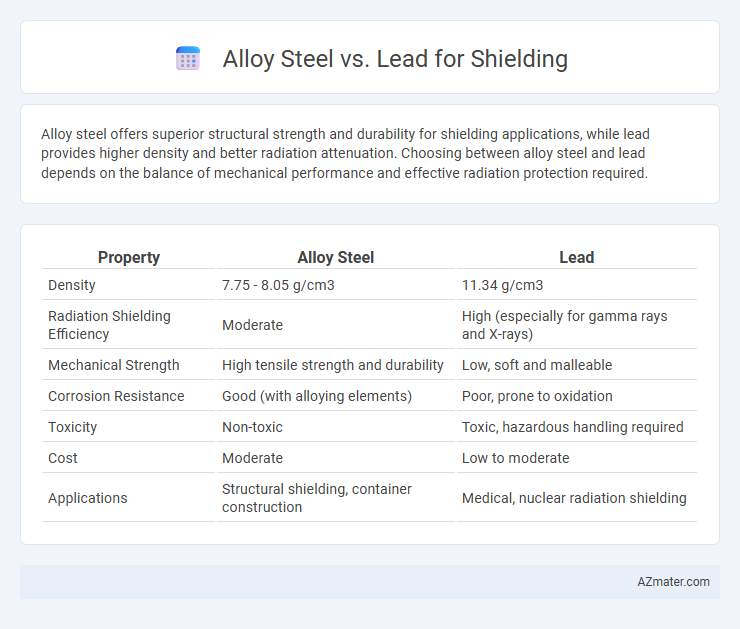Alloy steel offers superior structural strength and durability for shielding applications, while lead provides higher density and better radiation attenuation. Choosing between alloy steel and lead depends on the balance of mechanical performance and effective radiation protection required.
Table of Comparison
| Property | Alloy Steel | Lead |
|---|---|---|
| Density | 7.75 - 8.05 g/cm3 | 11.34 g/cm3 |
| Radiation Shielding Efficiency | Moderate | High (especially for gamma rays and X-rays) |
| Mechanical Strength | High tensile strength and durability | Low, soft and malleable |
| Corrosion Resistance | Good (with alloying elements) | Poor, prone to oxidation |
| Toxicity | Non-toxic | Toxic, hazardous handling required |
| Cost | Moderate | Low to moderate |
| Applications | Structural shielding, container construction | Medical, nuclear radiation shielding |
Introduction to Radiation Shielding Materials
Radiation shielding materials are essential for protecting against harmful ionizing radiation in medical, industrial, and nuclear applications. Alloy steel offers high strength, durability, and moderate radiation attenuation, making it suitable for structural shielding components where mechanical performance is critical. Lead, known for its high density and excellent radiation absorption properties, remains the preferred choice for shielding gamma rays and X-rays due to its superior effectiveness and ease of fabrication into protective barriers.
Key Properties of Alloy Steel
Alloy steel offers superior strength, durability, and corrosion resistance compared to lead, making it an effective shielding material in demanding environments. Its high density and hardness allow for efficient radiation attenuation while maintaining structural integrity under mechanical stress. Alloy steel's thermal stability and recyclability further enhance its suitability for long-term shielding applications.
Lead as a Traditional Shielding Material
Lead remains a traditional shielding material widely used for its high density and excellent attenuation of gamma rays and X-rays, making it indispensable in medical and industrial radiation protection. Alloy steel, while less dense, offers improved mechanical strength and structural durability, suitable for environments requiring robust physical protection alongside radiation shielding. The choice between lead and alloy steel depends on balancing weight, ease of fabrication, toxicity, and specific radiation attenuation requirements.
Comparative Effectiveness: Alloy Steel vs Lead
Alloy steel offers superior structural strength and durability compared to lead, making it more suitable for shielding in environments requiring mechanical resilience. Lead excels in radiation shielding due to its high density and atomic number, effectively attenuating gamma rays and X-rays. However, alloy steel can provide adequate radiation shielding with thinner sections when combined with other materials, offering a balance between protection and weight.
Health and Environmental Considerations
Alloy steel offers superior durability and strength without the toxicity risks associated with lead, making it a safer option for radiation shielding in healthcare and industrial settings. Lead poses significant health hazards, including lead poisoning and neurological damage, and its environmental impact involves contamination of soil and water, necessitating careful disposal and regulatory compliance. Using alloy steel reduces long-term environmental liabilities and supports safer handling procedures while maintaining effective radiation protection.
Cost and Availability of Shielding Materials
Alloy steel offers a cost-effective solution for radiation shielding due to its widespread availability and lower manufacturing expenses compared to lead. Lead, while traditionally favored for its high density and superior attenuation properties, often incurs higher costs and supply limitations driven by environmental regulations and mining constraints. Selecting alloy steel for shielding applications can reduce material and handling costs, especially when balancing budget with acceptable protective performance.
Mechanical Strength and Durability
Alloy steel offers superior mechanical strength and durability compared to lead, making it ideal for structural shielding applications that demand resistance to impact and deformation. While lead provides excellent radiation shielding due to its high density, it is significantly softer and prone to wear, corrosion, and mechanical failure under stress. Alloy steel's enhanced tensile strength and corrosion resistance extend the lifespan of the shielding, especially in harsh or load-bearing environments.
Applications in Medical and Industrial Settings
Alloy steel offers robust durability and strength, making it ideal for protective enclosures and structural components in medical imaging devices like X-ray machines, where precise shielding is crucial. Lead remains the preferred material for radiation shielding in both medical and industrial settings due to its high density and excellent attenuation properties, effectively absorbing gamma and X-rays in environments such as radiology rooms and nuclear power plants. While alloy steel provides mechanical support and structural integrity, lead is primarily used for direct radiation protection, ensuring safety compliance in healthcare diagnostics and industrial radiography.
Innovations and Future Trends in Shielding
Innovations in shielding materials emphasize the superior strength-to-weight ratio and corrosion resistance of alloy steel, which enables the development of thinner, more durable protective barriers compared to traditional lead shielding. Future trends highlight the integration of nanotechnology and composite materials to enhance the radiation attenuation properties of alloy steel, reducing environmental hazards associated with lead disposal. Research is advancing toward customizable alloy steel formulations that optimize shielding effectiveness while maintaining sustainability and regulatory compliance.
Summary: Choosing the Optimal Shielding Material
Alloy steel offers high strength and durability with moderate radiation shielding properties, making it suitable for structural applications requiring impact resistance and gamma radiation protection. Lead provides superior radiation attenuation due to its high density but lacks mechanical strength and is more toxic, requiring careful handling and environmental considerations. Selecting the optimal shielding material depends on balancing radiation protection effectiveness, mechanical requirements, toxicity, and application-specific constraints.

Infographic: Alloy steel vs Lead for Shielding
 azmater.com
azmater.com